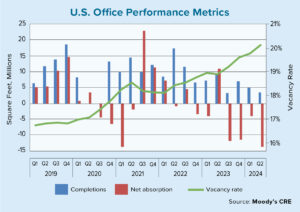It has been roughly a decade since the last serious economic downturn gripped our nation. Back then, commercial mortgage brokers had to scramble to find and close deals. The ones who made it to the other side of that deep recession are now challenged to succeed amidst an unprecedented crisis created by the COVID-19 pandemic. But how will they make it this time?
Brokers bring various skills to bear in helping small-business clients grow and create jobs, including knowledge of their markets and industries, relationship building and personal tenacity. But it’s fair to suggest that those with a solid knowledge of the available financing tools will remain a step ahead of their peers as the economy begins to recover. One of the more versatile — and yet underused — financing tools is the 504 refinance program from the U.S. Small Business Administration (SBA), which can be used to rid a small business of costly private debt and generate positive cash flow.
Widely used to help small-business entrepreneurs buy commercial real estate, the SBA 504 program was temporarily modified after the Great Recession, allowing small-business owners to consolidate and refinance commercial real estate debt and business expenses. Fortunately, in 2016, the refinance option was made permanent and now can be used by small-business owners to ease their financial burdens and weather the current recession.
Before laying out the specifics of the 504 refinance, it’s important to have a good understanding of how the program is structured and its benefits for small-business clients. An SBA 504 loan package is a collaboration between a bank, a certified development company (CDC) and a small-business owner. In many cases, the business owner uses the 504 loan to buy a commercial property that it plans to occupy. The bank typically finances 50% of the project, the CDC provides 40% via a second mortgage and the small-business borrower contributes 10%.
The program is notable for its high leverage, as well as below-market, fixed interest rates and amortization periods up to 25 years. There also are no balloon payments. SBA’s 504 refinance program offers a similar benefit as its purchase loan option. Multiple commercial mortgages can be consolidated and refinanced at below-market rates, as long as they are not already guaranteed by the SBA. The key point is that the refinance can provide valuable cash flow and monthly savings that can be reinvested back into the business.
Refi options
There are two ways small-business owners can benefit from the SBA refinance program: a straight refinance and a cash-out version. The first option refinances existing, non-SBA-guaranteed commercial real estate debt. Small-business owners can refinance up to 90% of the appraised value of an owner-occupied property. In other words, the loan-to-value (LTV) ratio can be as much as 90% even when you combine multiple mortgages secured against a property into a single loan.
With the cash-out refi option, borrowers can tap their equity for working capital. A business can use the proceeds to cover expenses, such as payroll, inventory and day-to-day operations. In this case, the maximum LTV is 85%. As much as 20% of the appraised value can be harnessed as working capital.
SBA programs can’t be used to refinance every type of loan, however. Importantly, an existing SBA 504 or SBA 7(a) loan cannot be refinanced through the program. A qualifying small business can, however, refinance one or more non-SBA-guaranteed commercial mortgages just as long as they’re secured to the same eligible fixed asset.
There are other restrictions as well. The loans to be refinanced must be at least 24 months old and in good standing for the previous 12 months. Also, the business in question must have been operating for at least two years with no full or partial ownership changes prior to the refinance application. The business must occupy at least 51% of the property at the time of the application.
To be sure, the workings of the SBA refinance program can appear complicated and time-consuming. In actuality, the typical time it takes to refinance using a 504 loan is comparable to that of a conventional real estate loan. There are a few more forms and some document research on the existing debt to be refinanced. Mortgage brokers, however, don’t have to get bogged down with these issues if they reach out and partner with a CDC that has expertise closing these loans.
Getting help
CDC loan officers can assist mortgage brokers in a number of ways, including the first steps of checking the borrower’s eligibility, prequalifying and structuring the deal for quick SBA approval. Reputable CDCs maintain relationships with various banks and tend to know the bank’s credit parameters. The CDC can query banks on behalf of your client or work with the client’s bank of choice.
About 250 CDCs operate throughout the country. Brokers interested in researching CDCs in their state can visit the National Association of Development Companies and click on the appropriate state to get the list of CDCs in their region.
Part of a broker’s due diligence should be to prioritize the CDCs that have closed the greatest volume of refinance deals using the SBA 504 loan. There’s no substitute for experience.
Preparation is the key to a smooth refi process. To avoid hiccups and 11th-hour snags, you and your clients need to do some ground work. First, collect important financial records. As part of the qualification process, an SBA 504 lender will ask your client for the existing commercial mortgage documents.
You will need to be upfront about any past credit issues your client may have had. If the borrower has run into credit issues in recent years, whether personally or as a business owner, these are not necessarily deal breakers when it comes to qualifying for an SBA 504 refinance, but it’s better to disclose them early on and thoroughly explain them to a lender. Because 504 loans are backed by the SBA, CDCs are able to consider businesses that traditional lenders might reject as too risky because of a slightly imperfect credit history.
Also, advise your clients to remain financially savvy and conservative during the application process. As your client gets ready to apply for a refinance, it’s more important than ever to be financially responsible and avoid running up short-term debt. The better you look on paper, the better your chances are of qualifying.
Finding clients
As brokers, you will need to scan the pandemic-laced landscape for potential clients. One strategy worth considering is to focus on small businesses within industries that have thrived amid the economic downturn. These include cleaning-service and -product providers; food- and product-delivery services; independent grocery stores; food manufacturers; game makers; home fitness-equipment manufacturers; and home- and garden-product manufacturers and retailers.
Moving forward, brokers should note that lenders are continually proposing changes to the SBA 504 program. These changes are intended to streamline and generally improve the experience for all 504 partners. As small-business entrepreneurs continue to recover from the ongoing pandemic, the best way to stay on top of 504 program changes is to remain in contact with CDC loan officers, who regularly monitor program progress.
Finally, beyond 504 financing, brokers can help themselves by staying current on other SBA loan options that can address their clients’ particular needs. For example, the SBA 7(a) Community Advantage program remains a viable option for small-business owners who need working capital of up to $250,000 to get them over the financial hump. And, best of all, SBA loan rates have remained near their lowest levels in the program’s history.
● ● ●
Small businesses have formed the backbone of America’s economy for hundreds of years. They are resilient. Some, unfortunately, may fade away, but mortgage brokers can rely on entrepreneurs to innovate during these challenging times and reinvigorate our economy once again. Brokers who stay committed to meeting the needs of these small-business owners will find themselves on the positive side of the nation’s recovery. ●
Author
-

Kurt Chilcott is president and CEO of CDC Small Business Finance, a nonprofit certified development company established in 1978. Chilcott is a nationally recognized leader in economic and community development and small-business finance. Under Chilcott’s leadership, CDC Small Business Finance has led the nation in SBA 504 loan production for nearly 20 years. It has leveraged $13.8 billion in small-business loans since its inception.
View all posts





